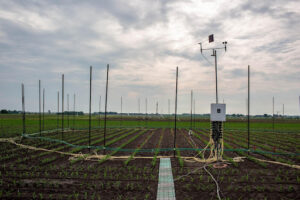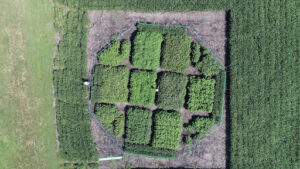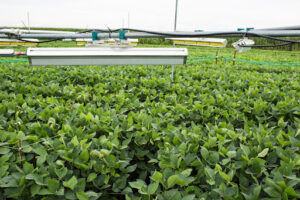First used in 2002, the Soybean Free Air Concentration Enrichment (SoyFACE) facility is located on the South Farms at the University of Illinois. This innovative facility is used for growing crops in the field in altered atmospheric conditions. The FACE technology increases concentrations of carbon dioxide and ozone across large (20 m diameter), octagonal plots. Using this technology, crops can be grown under typical farm-field conditions, but with future atmospheric concentrations of gases.
Currently, atmospheric carbon dioxide concentration is 42% higher than it was before the Industrial Revolution, and is expected to reach ~550 parts per million by the middle of the century (for millions of years it fluctuated between 150 ppm and 300 ppm). Similarly, background ozone concentrations have roughly doubled since the Industrial Revolution and ozone pollution is increasing in some parts of the world.
The FACE (Free Air Concentration Enrichment) facility was designed to discover the effects of these atmospheric changes on the productivity of crops as well as to find solutions that will help crops adapt to future atmospheric conditions. Crops that have been tested at the facility include bioenergy sorghum, cassava, corn, soybean, switchgrass, and many others.
How are predictions made by SoyFACE different?
Free Air Concentration Enrichment (FACE) technology allows for the controlled release of carbon dioxide or air enriched with ozone within an open field environment, simulating real-world agricultural conditions. Previous predictions of what future crop yield may be came from experiments in a greenhouse and looked mostly at carbon dioxide effects, not ozone.
Won’t the wind blow away these gases?
SoyFACE uses replicated 20 m diameter octagonal plots located throughout a 32-hectare field. In the center of each FACE plot, a small weather station measures wind velocity and direction, and gas is sampled to measure carbon dioxide and ozone concentration every 4 seconds. This information is then fed into a computer which releases gases on the side of the ring where the wind will distribute them across the plot.
The large scale of this technology allows researchers to assess the effects of atmospheric change on crop growth, physiology, and agronomy. The large size of the FACE plots has also enabled experiments with infrared heating and awnings to catch rainfall so that the interactive effects of rising atmospheric carbon dioxide, temperature, and drought stress can be measured.
This research facility aims to understand how crops respond to global atmospheric change, as well as provide a facility for testing genetic variation in crop responses and strategies to increase yields under future atmospheric and environmental conditions.
SoyFACE is directed by Lisa Ainsworth, Research Leader of the U.S. Department of Agriculture, Agricultural Research Service Global Change and Photosynthesis Research Unit. For more information on the experiment layout and how it works visit: https://soyface.illinois.edu/current-experiments/.
SoyFACE Research Facility at the University of Illinois South Farms – 1112 County Road 1200 E, Champaign
The fields where crops are grown for the SoyFACE project can be found at this facility.
Ainsworth, L. (N.d.). Research. Lisa Ainsworth’s Laboratory. https://lab.igb.illinois.edu/ainsworth/research.
Aspray, E.K., Mies, T.A., McGrath, J.A. et al. (2023). Two decades of fumigation data from the Soybean Free Air Concentration Enrichment facility. Sci Data 10(226). https://doi.org/10.1038/s41597-023-02118-x.
SoyFACE. (N.d.). Current Experiments. SoyFACE at the University of Illinois. https://soyface.illinois.edu/current-experiments/.



